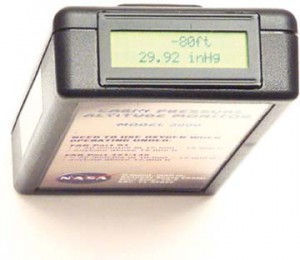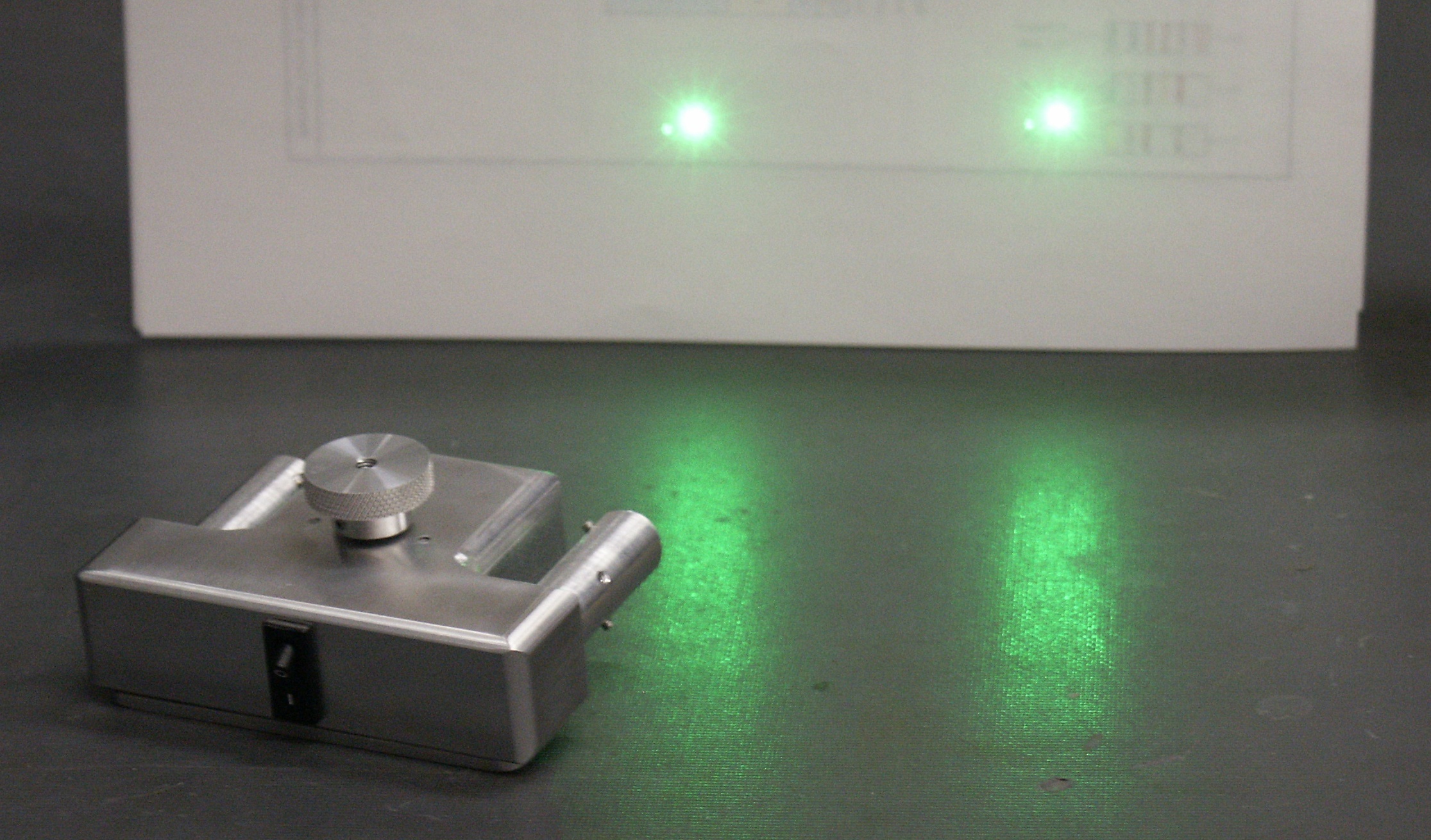By Carol Anne Dunn
For fiscal year 2005, the Inventions and Contributions Board presented 2,917 NASA employees and contractors with more than $1,951,000 in Space Act Awards.  In this issue of ASK, we will focus on the Personal Cabin Pressure Altitude Monitor and Warning System, an invention from Jan Zysko at Kennedy Space Center. The cabin pressure monitor may some day be instrumental in providing a safe environment on small planes and commuter jets where oxygen levels can plunge insidiously and dangerously in a very short time.
In this issue of ASK, we will focus on the Personal Cabin Pressure Altitude Monitor and Warning System, an invention from Jan Zysko at Kennedy Space Center. The cabin pressure monitor may some day be instrumental in providing a safe environment on small planes and commuter jets where oxygen levels can plunge insidiously and dangerously in a very short time.
–Roger Forsgren,
Director of the Inventions and Contributions Board
When pilot Steve Fossett began his historic, solo, nonstop flights around the world in the Virgin Atlantic GlobalFlyer aircraft on February 28, 2005, and February 8, 2006, an upgraded version of Kennedy Space Center’s personal cabin pressure monitor went with him. The device recognizes potentially dangerous or deteriorating cabin pressure conditions and alerts the pilot of the need for supplemental oxygen.
The Personal Cabin Pressure Altitude Monitor and Warning System, which won the NASA Commercial Invention of the Year and Government Invention of the Year awards for 2003, grew out of a project to create a vacuum chamber that would allow astronauts to work in simulated lunar and Mars environments. Jan Zysko, the inventor of the award-winning device, and his team were concerned about air evacuating the chamber while people were still inside. Depressurization of this kind can cause hypoxia, which is a state of oxygen deficiency in the blood, tissues, and cells sufficient to impair functions of the brain and other organs.
Hypoxia is also a concern to flight crews when flying above 10,000 feet because the partial pressure of oxygen—and therefore the oxygen available to breathe—is reduced as altitude increases. The problem is particularly treacherous because oxygen starvation quickly affects the brain, diminishing the ability to recognize and respond to the crisis. Throughout aviation history, there have been numerous incidents where aircraft crewmembers and passengers have been incapacitated by hypoxia.
In fact, two events involving depressurization happened while Zysko’s team was investigating how to alert occupants that a “pump down” was occurring in their chamber and revealed the need for a solution elsewhere as well. In June 1997, a cargo craft called Progress collided with the Russian Mir space station, which had three astronauts on board. The cargo craft damaged one of Mir’s six modules and caused a loss in air pressure. The crew hurriedly sealed off the module to prevent a further drop in pressure in the rest of the station.
 About two years later, in October 1999, a Lear 35 jet veered off course and flew aimlessly until it ran out of fuel and crashed, killing both pilots and all four passengers, including professional golfer and 1999 U.S. Open winner Payne Stewart. U.S. Air Force pilots flying alongside the plane reported that the cockpit windows were obscured by frost, a condition consistent with a loss of pressurization and a subsequent rapid drop of temperature.
About two years later, in October 1999, a Lear 35 jet veered off course and flew aimlessly until it ran out of fuel and crashed, killing both pilots and all four passengers, including professional golfer and 1999 U.S. Open winner Payne Stewart. U.S. Air Force pilots flying alongside the plane reported that the cockpit windows were obscured by frost, a condition consistent with a loss of pressurization and a subsequent rapid drop of temperature.
After the Payne Stewart accident, Zysko went home for the holidays and began working on a prototype of the cabin pressure monitor in his home shop. “Luckily, I had ordered some transducers to do some other work, but I integrated them into the system just to test the concept and see if we could accurately model the atmosphere with a small, portable device,” he said. A transducer is a small mechanism that converts one kind of energy into another, in this case translating atmospheric pressure into voltage. Zysko wanted to see if the transducer could be programmed to indicate depressurization, so he created a prototype that he brought back to work in January.
He proposed using his new project idea as an avenue for exploration in the Multidiscipline Sensors Program, the program he worked under for the atmospheric chamber. His request was approved, and a small amount of program funding was earmarked for his project. Zysko was also able to work with his existing team since his project occurred within the same program.
With funding and a familiar team behind the project, the toughest challenge was ensuring the transducer was accurate over a wide range of pressures and temperatures. Transducers tend to be very temperature sensitive, and the temperature on an airplane can fluctuate depending on ground temperature while sitting on a runway (be it in Alaska or Arizona) and the cooler temperatures at higher altitudes. To test accuracy, the pressure transducers were calibrated in a temperature-controlled environmental chamber. Zysko’s team allowed the units to stabilize at a target temperature, then varied and measured the pressure through their desired range, about 1,000 feet below sea level to 45,000 feet above. Their goal was to have the unit accurate to about 100 feet, or one percent, over a typical aircraft’s altitude range while varying temperature from about 32 degrees to 110 degrees Fahrenheit.
Before creating a preproduction model for testing, the Applied Technology Office researched cases of depressurization in the aviation industry and contacted the National Safety Transportation Board (NTSB) to hear what that organization thought about the monitor’s development and pilots’ interest in such an invention. The board responded positively, then asked Zysko’s team to visit and speak to one of their accident investigation teams about depressurization. The NTSB team turned out to be investigating the Payne Stewart incident.
With encouragement from the NTSB, Zysko’s team created a production model. About the size of a large pager, the Personal Cabin Pressure Altitude Monitor and Warning System operates independently of other aircraft/spacecraft systems and tracks the pressure conditions of the local environment. The monitor warns, by means of audio, vibratory, and visual alarms, of the impending danger of hypoxia when cabin pressure has fallen to preprogrammed threshold levels. A lighted digital screen displays a text message of the warning and specifies the pressurized condition causing the alarm.
Human space operations can also benefit from the innovation in Low-Earth Orbit vehicles such as the space shuttle and space station, as well as long-duration interplanetary vehicles and future planetary habitats. Proposed ground-based applications include the Mars Simulation Chamber and the various pressure/vacuum chambers at NASA’s space flight and research centers. Applications in its existing form, beyond aviation and aerospace, include use as an altimeter and thermometer for mountain climbers and as a barometer and thermometer for meteorological measurements. With the selection of a different pressure transducer and software modification, the device could be used to track the pressure, depth, and time profiles in human-tended underwater habitats and hyperbaric chambers.
“If this technology can help to avoid even one incident or accident, it will have been worth all the effort and resources put forth,” Zysko said.
Zysko recently retired from the National Aeronautics and Space Administration, where he worked for more than seventeen years, and the National Oceanic and Atmospheric Administration, where he worked for fourteen years. Among his many positions at NASA, Zysko was chief of the Spaceport Engineering and Technology directorate’s data and electronic systems branch at Kennedy Space Center.
Note: NASA’s Kennedy Space Center’s Technology Transfer Office is currently seeking a licensee for the Personal Cabin Pressure Monitor. Potential licensees should call Jeff Kohler at 321-861-7158.
About the Author
 |
Carol Anne Dunn currently works as a Project Specialist in the Technology Transfer Office at Kennedy Space Center. She is also the Awards Liaison Officer for the Inventions and Contributions Board. |







